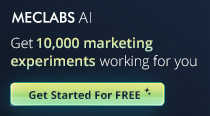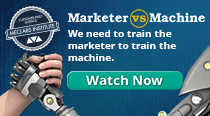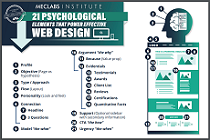
|
SUMMARY:
You don’t primarily sell consulting services. Or car parts. Or babysitting services. Or whatever your product or service actually is. The main thing you sell is trust. Customers will only bet their business on your service once they trust you. They will only allow your product into their home or car once they trust you. To give you ideas for how to build that trust, today we bring you a behind-the-scenes look at how a home service app startup used both mom bloggers and milk cartons to increase trust. |
Action Box: AI Guild
Join us for conversion-focused AI training from the lab that started it all. Get your free three-month scholarship (from MeclabsAI, MarketingSherpa’s parent company).
Rozie is an Uber-style marketplace for home cleaning.
“If your product involves strangers entering private space (cleaners, babysitters, dog walkers), budget first for trust fuel – faces your customers already know or objects that live inside their homes. Fancy funnels can wait,” advised Aleksandrs Tuls, Co-founder, Rozie.
Tuls gave MarketingSherpa a behind-the-scenes look at how his team did just that.
When Rozie launched in October 2024, the company had an app published in the Apple Store and Google Play with very little feedback and reviews, almost no content on Instagram/Facebook/TikTok pages, and the only ad campaign was Google Ads pointing straight to the app stores or to a landing page
Ads had messaging like ‘Request cleaning, just like a taxi or meal, with Rozie.”
Creative Sample #1: Sample of Google Ad creative
The ads got 40 to 45 people to install the app and register every day, about 1,200 registrations per month.
However, their ultimate conversion goal is a paid booking. And only about two percent of searches on the app went through every step of the process (user opens app à enters property address à waits for offers à chooses an offer) and made a paid booking.
The team interviewed early users to understand why they were not getting more paid bookings, and they heard feedback like ‘Is this cleaner real? Is your company even real?’
They realized that Rozie was brand new and had zero brand equity.
The partners brainstormed together and decided that this lack of trust was their biggest conversion hindrance.
They figured showing real-life examples with influencers would lead the ideal customer to the conclusion that the company and its cleaners were ‘real.’ “People trust people, not pixels. A five-star badge means nothing until someone they follow lets a stranger mop their kitchen,” Tuls said.
They focused their efforts on Instagram. “Our core users are 30+, working parents. In Malta that crowd scrolls Instagram way more than TikTok. TikTok’s audience is younger, so Instagram was the choice. We checked the topics potential influencers cover: lifestyle, family, hobbies – and picked the best fit,” he said.
The team focused on micro/mini creators, which they defined as having 2,000 to 20,000 Instagram followers because they wanted their ideal customer to feel like the influencers were ‘one of us’ and not just celebrities.
The team tracked brands with a similar audience and wrote down every creator those brands hired twice or more (which indicated to them that the brand was happy with the collaboration). They checked fake-follower ratios with online tools but also considered their gut feelings.
The team started with a couple of influencers to test results and saw positives very fast: people emailed in questions, asked support about specific app features, and they got more searches for cleaners in the app. So they ultimately chose 18 influencers with a combined 260,000 followers.
The team approached each influencer differently, offering varied deals along the way. Some wanted a one-time payment, others wanted several free cleanings. The most common deal was a free deep clean of the influencer’s home plus a $100 to $400 payment per post based on their reach and engagement. The team made sure each influencer only posted once every week or every other weeks so their Instagram feed never felt spammy.
Once a collab was approved, the creative brief was simple – ‘we want honest feedback.’ If the influencer liked the service, they should post natural feedback and suggest using the app. They were given total freedom on how and what to film/post so the content matched their style.
While the campaign was very digital, mobile, online, social, etc…the team realized that offline advertising could also be very good at building enough trust to get potential users to invite a stranger into a home.
First, they invested $1,200 and three Saturdays of staff time handing out coupons near shopping centers, but that did not move the needle.
So they focused on a communication device that the ideal customer brought into their home regularly – a milk carton.
They bought a milk carton ad, and in March 2025 appeared on 250,000 bright-yellow milk cartons with the headline ‘Too busy to clean your house?’ along with a QR code.
Creative Sample #2: Milk carton ad
The cartons had to be designed two months before the ad ran, so they kept influencer posts going all winter.
Let’s look at a comparison of the October-to-December-2024 timeframe when the team was only using Google Ads to the April-May-2025 timeframe after the influencers + milk carton advertising campaign had been rolling:
In addition, they onboarded 4.4x more service providers, growing from 45 to 200.
The Google Ads cost $4.25 per registration versus $3.80 per registration for the Instagram campaign, but the influencers also lifted final conversion.
Some influencer collabs almost crashed the app from traffic while others had zero effect. “The only posts that tanked were over-produced reels with voice-overs we clearly didn’t ask for,” he said.
One 15,000-follower mom blogger outsold a 90,000-follower beauty guru 6:1. One influencer looked perfect on many platforms but had zero effect and even bought video views.
The best result came from an influencer with normal follower numbers but a super-engaged audience – 1,000 registrations and several hundred cleaner searches in two days. Now they’re signing the influencer as a brand ambassador for regular content.
“Feedback on Trustpilot and app stores is not enough. You need real-world advocates and nothing is better than feedback of someone you might know or follow,” Tuls said.
“Seeing the same logo on a phone screen and on breakfast milk flips a mental switch: ‘these guys must be legit,’” Tuls concluded.
The milk carton ads also helped build credibility with influencers. “The milk ads didn’t bring instant traffic, but feedback from creators was great. Some even said our app is ‘everywhere’ now,” he said.
Survey feedback now shows that trust concerns are far less prominent than they were six months ago.
This article was originally published in the MarketingSherpa email newsletter.
Profitable Instagram Niches: How specialized creative businesses used paid and unpaid tactics
Influencer Marketing: Focus on one thing (podcast episode #139)
Get Better Business Results With a Skillfully Applied Customer-first Marketing Strategy

The customer-first approach of MarketingSherpa’s agency services can help you build the most effective strategy to serve customers and improve results, and then implement it across every customer touchpoint.
Get More Info >MECLABS AI

Get headlines, value prop, competitive analysis, and more.
Use the AI for FREE (for now) >Marketer Vs Machine

Marketer Vs Machine: We need to train the marketer to train the machine.
Watch Now >Live, Interactive Event

Join Flint McGlaughlin for Design Your Offer on May 22nd at 1 pm ET. You’ll learn proven strategies that drive real business results.
Get Your Scholarship >Free Marketing Course

Become a Marketer-Philosopher: Create and optimize high-converting webpages (with this free online marketing course)
See Course >Project and Ideas Pitch Template

A free template to help you win approval for your proposed projects and campaigns
Get the Template >Six Quick CTA checklists

These CTA checklists are specifically designed for your team — something practical to hold up against your CTAs to help the time-pressed marketer quickly consider the customer psychology of your “asks” and how you can improve them.
Get the Checklists >Infographic: How to Create a Model of Your Customer’s Mind

You need a repeatable methodology focused on building your organization’s customer wisdom throughout your campaigns and websites. This infographic can get you started.
Get the Infographic >Infographic: 21 Psychological Elements that Power Effective Web Design

To build an effective page from scratch, you need to begin with the psychology of your customer. This infographic can get you started.
Get the Infographic >Receive the latest case studies and data on email, lead gen, and social media along with MarketingSherpa updates and promotions.